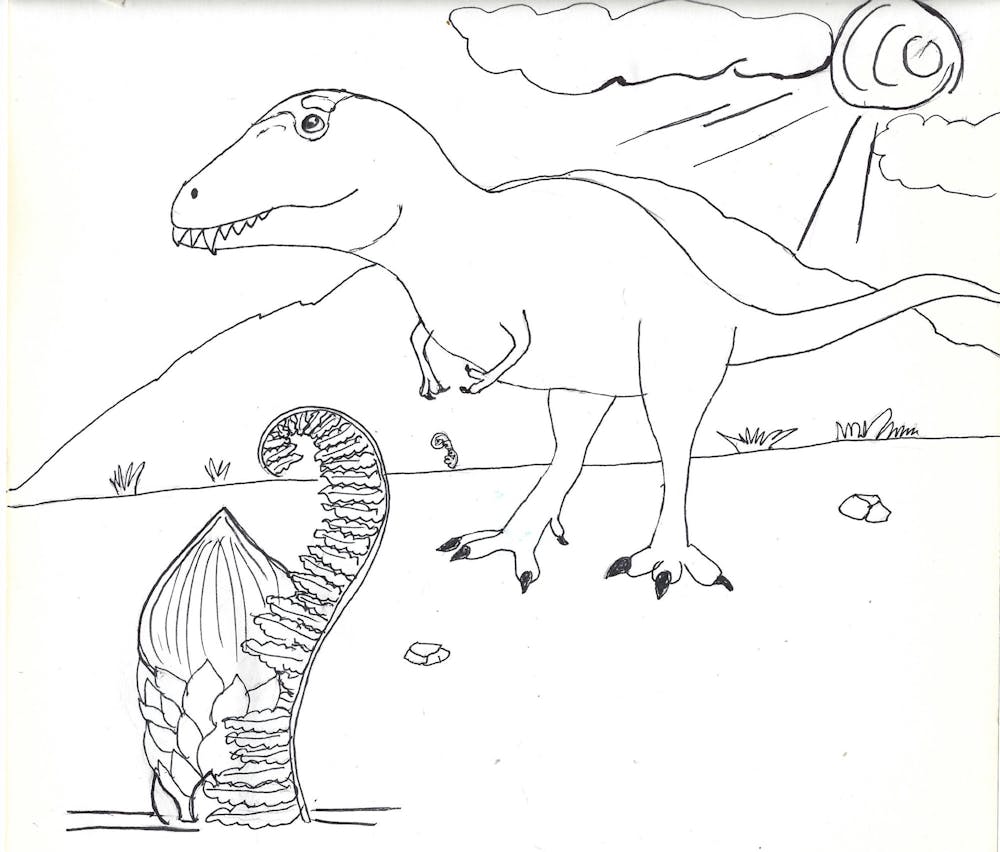New Mexico, once a place of flood plains and swamps, has been home to many dinosaur discoveries. This is largely due to the state’s geographical history, according to three experts.
One dinosaur was identified in January as a new subspecies of Tyrannosaurus that predates the T. Rex by up to 7 million years.
The discovery of T. mcraeensis resulted from a study of a jaw and partial skull fossil that were found in the 1980s-90s by boaters and museum staff in southern New Mexico, according to the New Mexico Museum of Natural History and Science.
Spencer Lucas, curator of paleontology at the NMMNHS, was a contributor to the research and an author of the study.
The fossil was first thought to be a T. rex, but the research — conducted in part by NMMNHS — identified the fossil as larger and more primitive than a T. rex’s. The discovery of T. mcraeensis suggests that Tyrannosaurus species existed in North America much earlier than previously thought, according to Lucas.
“There’s been a lot of debate about where T. rex came from. One possibility is that it originated in Asia and emigrated across the Bering land bridge to get to western North America. But the other idea is that T. rex originated in North America, and this fossil supports that idea,” Lucas said.
T. mcraeensis existed during the Cretaceous period — 145 to 66 million years ago — when North America was divided by the Western Interior Seaway. The WIS was created by subducting plates and globally rising sea levels that resulted in ocean waters filling up a basin that started in the North Pole and emptied into the Gulf of Mexico.
Most of the fossil discoveries made in New Mexico are from the Cretaceous period, according to Phil Gensler, a regional paleontologist for the New Mexico Bureau of Land Management.
Paleontology is one of the many areas the New Mexico BLM is supposed to manage and protect, according to Gensler.
“What gets preserved here (are) the animals and the dinosaurs that lived along the Western interior Seaway. So where New Mexico sits would have been on the western shoreline of that seaway. There were a lot of flood plains and swamps … and that also helped a lot in preserving (animals and dinosaurs) once they died,” Gensler said.
Many aquatic species swam through the WIS, including mosasaurs, large carnivorous fish like xiphactinus, and sharks, according to Gensler.
The main ranges of the Rocky Mountains began to form in North America 70-40 million years ago, according to the National Park Service.
Get content from The Daily Lobo delivered to your inbox
Robert Villa, president of the Tucson Herpetological Society, has studied and experienced the natural environment of the southwestern desert through his work in the Sonoran Desert and surrounding areas, he said.
“The Rocky Mountains are really the geological formation that (is) responsible for the climate of the Southwest,” Villa said.
The Rocky Mountains play a role in creating the southwestern desert climate through what is called a rain shadow, according to Wild Earth Lab. The mountains act as a barrier between the Pacific Ocean and inland.
When warm Pacific air rises, it has to travel high over the Rocky Mountains, where it cools, condenses and falls as precipitation. The air that travels over the mountains is hence cool and dry, creating the desert climate on the other side, according to Wild Earth Lab.
After the formation of the Rocky Mountains, the familiar southwestern desert climate began to take shape, Villa said. Formerly tropical flora and fauna either moved south over time to warmer and wetter climates or adapted to the new cold, dry climate. Those that couldn’t handle the change went extinct, according to Villa.
“The uplift of those mountains had a big effect on the biodiversity in North America. You had just as much extinction and just as many new species evolving,” Villa said.
New Mexico ranks fourth in the country for dinosaur fossil discovery, with 935 fossils found, according to a December 2023 USA Today article.
“New Mexico is a big dinosaur state. The state fossil, Coelophysis, is one of the earliest dinosaurs and it’s a very well known early dinosaur … If you look at the history of dinosaur collecting in New Mexico, it’s been quite extensive … a lot of the big museums used to come here and collect dinosaurs, and it's a magnet to paleontologists,” Lucas said.
The earliest fossils brought to scientific attention in New Mexico emerged in the 1840s, but local Indigenous groups collected fossils before then, Lucas said.
Part of Villa’s work and exploration is bridging Indigenous and Western science, which applies to understanding the Southwest’s geological history, Villa said.
“My frontier of exploration is figuring out how to bring academic science and Indigenous science to learn from each other and create questions together … Exploration is getting people from diverse lived experiences and knowledge sets to create better questions that will help us get through into the future, whether it's about climate change, or whether it’s understanding the biodiversity of the desert,” Villa said.
Leila Chapa is a freelance reporter for the Daily Lobo. She can be reached at news@dailylobo.com






